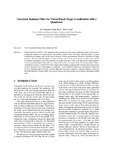- CERES Home
- →
- Cranfield Defence and Security
- →
- Staff publications (CDS)
- →
- View Item
JavaScript is disabled for your browser. Some features of this site may not work without it.
| dc.contributor.author | Dena Ruiz, J A | |
| dc.contributor.author | Aouf, Nabil | |
| dc.date.accessioned | 2017-08-24T09:40:02Z | |
| dc.date.available | 2017-08-24T09:40:02Z | |
| dc.date.issued | 2017-07-28 | |
| dc.identifier.citation | Dena Ruiz JA, Aouf N (2017) Unscented Kalman Filter for Vision Based Target Localisation with a Quadrotor. 14th International Conference on Informatics in Control, Automation and Robotics (ICINCO); Madrid 26-28/07/2017 | en_UK |
| dc.identifier.uri | http://dspace.lib.cranfield.ac.uk/handle/1826/12372 | |
| dc.description.abstract | Unmanned aerial vehicles (UAV) equipped with a navigation system and an embedded camera can be used to estimate the position of a desired target. The relative position of the UAV along with knowledge of camera orientation and imagery data can be used to produce bearing measurements that allow estimation of target position. The filter methods applied are prone to biases due to noisy measurements. Further noise may be encountered depending on the UAV trajectory for target localisation. This work presents the implementation of an Unscented Kalman Filter (UKF) to estimate the position of a target on the 3D cartesian plane within a small indoor scenario. A small UAV with a single board computer, equipped with a frontal camera and moving in an oval trajectory at a fixed height was employed. Such a trajectory enabled an experimental comparison of UAV simulation data with UAV real-time flight data for indoor conditions. Optitrack Motion system and the Robot Operative System (ROS) were used to retrieve the drone position and exchange information at high rates. | en_UK |
| dc.language.iso | en | en_UK |
| dc.publisher | SCITEPress | en_UK |
| dc.title | Unscented Kalman Filter for Vision Based Target Localisation with a Quadrotor | en_UK |
| dc.type | Conference paper | en_UK |
Files in this item
This item appears in the following Collection(s)
-
Staff publications (CDS) [1209]
